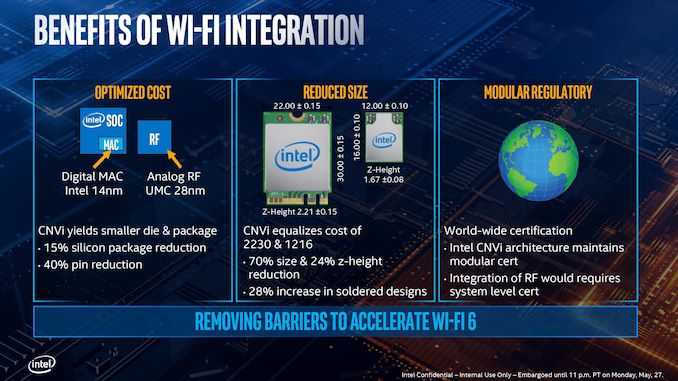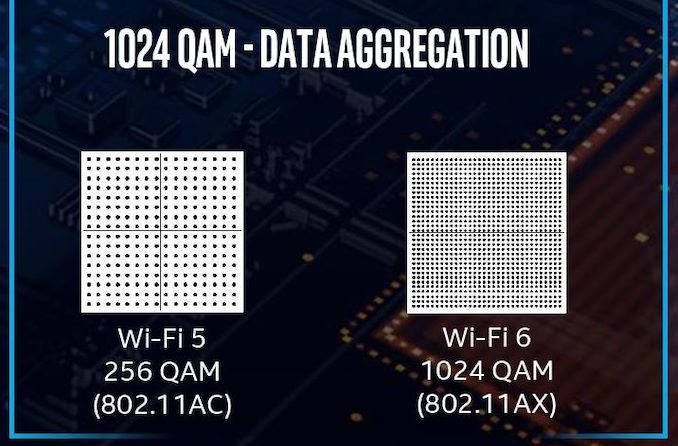Examining Intel's Ice Lake Processors: Taking a Bite of the Sunny Cove Microarchitecture
by Dr. Ian Cutress on July 30, 2019 9:30 AM EST- Posted in
- CPUs
- Intel
- 10nm
- Microarchitecture
- Ice Lake
- Project Athena
- Sunny Cove
- Gen11
Wi-Fi 6: Implementing AX over AC*
In consumer products, Intel has been placing its new Wi-Fi initiative into every chipset it can find. We’ve seen CNVi-enabled solutions occur on the desktop and in the notebook space for almost two years now, with the goal to make high-performance and low-power Wi-Fi ubiquitous, and to push Intel’s wireless solutions everywhere. Ice Lake is where Intel enables Wi-Fi 6 in such a solution.
If you’ve never come across the term CNVi before, it is Intel’s proprietary interface link and controller which connects the logic parts of the wireless connection on the chipset to the antenna and radio frequency analog parts which are found on a different module. This allows Intel’s partners to use different antenna ‘RF’ modules depending on what it wants to support, such as single antenna designs, dual antenna designs, or higher bandwidth modes.
Because CNVi is a proprietary interface, Intel has no plans to license it, and therefore the only RF modules you can buy to support it come from Intel. Intel states that its CNVi solution enables the high frequency digital logic to be built on its 14nm process with the chipset, and the RF analog side can be built on 28nm UMC which is better for analog signals and performance than any of Intel’s currently available manufacturing processes. Overall Intel states that using an external RF chip in this fashion affords a 15% silicon package reduction and a 40% pin reduction.
CNVi RF modules can either be an M.2 module (2230 = 22mm x 30mm) or as a soldered module (1216), which respectively allows for modularity, or for decreasing z-height for thin and light designs. Intel also states that this method of supplying the Wi-Fi, as separate digital and analog silicon, allows Wi-Fi certification to be done at the module level, rather than at the system level, simplifying the process for its partners.
As an overarching technology, Wi-Fi 6 promises better bandwidth than standard Wi-Fi 5, as well as support for more devices on the same network. Technically this increased bandwidth comes down to data/time aggregation through the air as a benefit of OFDMA support, as well as 1024-QAM signaling design rather than 256-QAM signaling for increased throughput.
Wi-Fi 6 also has a lot of additional optional elements to the standard, which Intel believes will cause a good deal of confusion in the market. Naturally, Intel suggests that its partners that use a CNVi Wi-Fi 6 implementation also promote Wi-Fi 6 access points built on Intel’s platforms for simpler integration.
At this point in time, there are two main Wi-Fi 6 controllers: Intel’s AX200/AX201 2x2 CNVi module which uses the on-die enhancements, and Rivet Network’s AX1650 M.2 module which doesn’t use any of the on-die enhancements as it connects through a PCIe lane on the chipset. Technically both are built with the same silicon, as the companies are working together on the design, however Rivet is implementing its own acceleration techniques due to engines inside the hardware.
*The asterisk in the title of this page is because you still need external hardware in order to enable it, and to do it in the best way requires Intel-only hardware. You can use other vendor hardware, but you don’t need something special on the SoC to enable that.













107 Comments
View All Comments
PeachNCream - Tuesday, July 30, 2019 - link
Are there really that many eGPUs out there though?HStewart - Tuesday, July 30, 2019 - link
Just do a search on amazon for eGPU and you find 3 pages full of then. ASUS, Gigibyte, and Dell are examples plus many 3rd party.PeachNCream - Tuesday, July 30, 2019 - link
Not for sale. Actually in use by people.The_Assimilator - Wednesday, July 31, 2019 - link
2.Retycint - Wednesday, July 31, 2019 - link
One of the reasons that eGPU adoption rates are low is precisely because of the limitation mentioned above - huge performance drop (anywhere from 30-50% I think) compared to PCI-E connection, due to bandwidth limitations.DanNeely - Wednesday, July 31, 2019 - link
The performance issue is TB3 overhead. Running a GPU on an internal PCIe3 x4 link will come within a few percent of an x16.repoman27 - Tuesday, July 30, 2019 - link
"There is still some communication back and forth with the chipset (PCH), as the Type-C ports need to have USB modes implemented."Just to add to that, all of the high-speed signaling (Thunderbolt, DisplayPort, SuperSpeed USB) is handled by the CPU die, and the PCH only transacts in USB 2.0 and the low-speed, out-of-band management channel for Thunderbolt (LSx).
I fully understand why you (Ian) included the asterisk, because many OEMs won't bother implementing Thunderbolt 3 due to the additional expense / complexity, but to be fair to Intel, they integrated Thunderbolt as much as they possibly could. It's really not feasible to include all of the power and analog signal conditioning necessary for Thunderbolt 3 on the CPU package.
Galatian - Tuesday, July 30, 2019 - link
The numbers of the iGPU don’t really add up. They are comparing their best new GPU to last Gens UHD 420. I don't see the performance gain.at8750 - Tuesday, July 30, 2019 - link
Probably,CML-U
i7-10510U 4C 1.8GHz TB:4.9/4.8/4.3GHz
i5-10210U 4C 1.6GHz TB:4.2/4.1/3.9GHz
ICL-U
i7-1065G7 4C 1.3GHz TB:3.9/3.8/3.5GHz
i5-1034G1 4C 0.8GHz TB:3.6/3.6/3.3GHz
digitalgriffin - Tuesday, July 30, 2019 - link
Ian,You do know pure Silicon is highly toxic? I wouldn't even hang it in your house unless it was plated in a clear lacquer. It degrades when exposed to open air. And it's been shown to cause cancer. I know you wouldn't actually bite it. But be sure to wash your hands.